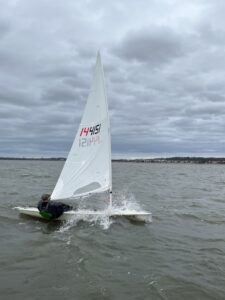This was my first windy day of this season! I tend to do better when it’s windy and today followed that trend. I usually attribute my better races in the heavy stuff to my height and weight, this helps but I’m sure there is also some technique in there. I had my outhaul pretty tight and was working my cunningham pretty hard, very tight up wind to depower and looser downwind for what I hoped gives some better shape. I also loosen my vang before the windward mark as I find the looser vang really helps with bearing away. Mostly I know the laser likes to be sailed flat which is a ton of work in heavy breeze. I’m not in as good shape as I have been in past seasons, so I definitely had some “fade” over the races. I was flat and fast in the first race to two, then I had to depower more and was not as sharp as the races progressed.

I like the triangular and olympic courses as the triangle legs require different strategy than the straight downwind legs. The first leg is more about staying in line and not getting rolled. The second leg is more aggressive, seeing if you can go above those in front to get an overlap and steal some wind. Nabeel managed to cruise past me to leeward once, the opposite of how it should work, which was very impressive. I find I’m not as fast downwind as others, but I can make up for it upwind (see flat and fast).
Lastly on windy days I try to minimize my tacks, for me this is a good way to get caught in irons or otherwise lose ground with a bad tack. James Jacob snuck past me with a much better tack near the end of the 5th race.
Thank you Kaitlyn and Lars for running RC and taking care of us out there!
Tom Hutton


